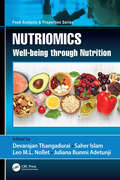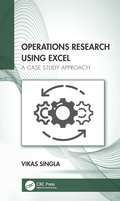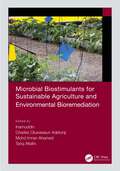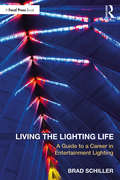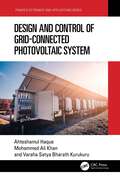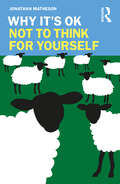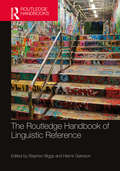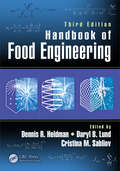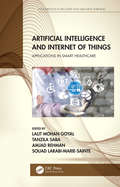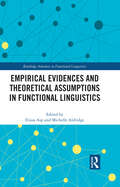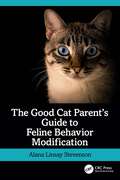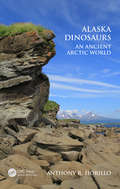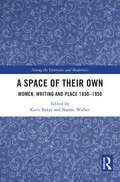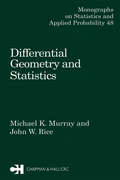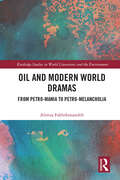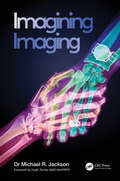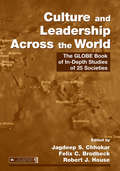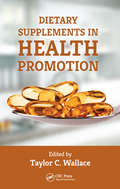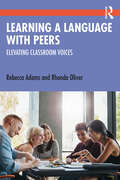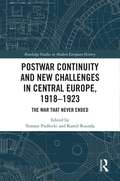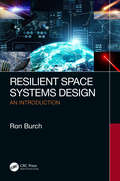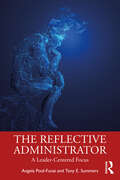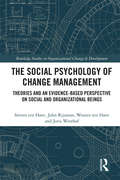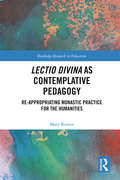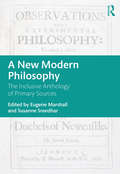- Table View
- List View
Nutriomics: Well-being through Nutrition (ISSN)
by Devarajan Thangadurai Saher Islam Leo M.L. Nollet Juliana Bunmi AdetunjiImplementation of robust omics technologies enables integrative and holistic interrogation related to nutrition by labeling biomarkers to empirically assess the dietary intake. Nutriomics: Well-being through Nutrition aims to enhance scientific evidence based on omics technologies and effectiveness of nutrition guidelines to promote well-being. It provides deep understanding towards nutrients and genotype effects on disease and health status. It also unveils the nutrient–health relation at the population and individual scale. This book helps to design the precise nutritional recommendations for prevention or treatment of nutrition-related syndromes.Nutriomics: Well-being through Nutrition focuses on: The impact of molecular approaches to revolutionize nutrition research for human well-being Various biomarkers for bioactive ingredient analysis in nutritional intervention research Potential of transcriptomic, genomic, proteomic, metabolomic, and epigenomic tools for nutrition care practices Recent updates on applications of omics technologies towards personalized nutrition Providing comprehensive reviews about omics technologies in nutritional science, Nutriomics: Well-being through Nutrition serves as an advanced source of reference for food developers, nutritionists, and dietary researchers to investigate and evaluate nutriomics tools for development of customized nutrition and food safety. It is also a useful source for clinicians and food industry officials who require intense knowledge about emerging dietary-related tools to revolutionize the nutrition industry.This is a volume in the Food Analysis and Properties series, a series designed to provide state-of-art coverage on topics to the understanding of physical, chemical, and functional properties of foods.
Operations Research Using Excel: A Case Study Approach
by Vikas SinglaThe field of operations research provides a scientific approach to managerial decision making. In a contemporary, hypercompetitive ever-changing business world, a manager needs quantitative and factual ways of solving problems related to optimal allocation of resources, profit/loss, maximization/minimization etc. In this endeavor, the subject of doing research on how to manage and make operations efficient is termed as Operations Research. The reference text provides conceptual and analytical knowledge for various operations research techniques. Readers, especially students of this subject, are skeptic in dealing with the subject because of its emphasis on mathematics. However, this book has tried to remove such doubts by focusing on the application part of OR techniques with minimal usage of mathematics. The attempt was to make students comfortable with some complicated topics of the subject. It covers important concepts including sensitivity analysis, duality theory, transportation solution method, Hungarian algorithm, program evaluation and review technique and periodic review system. Aimed at senior undergraduate and graduate students in the fields of mechanical engineering, civil engineering, industrial engineering and production engineering, this book:• Discusses extensive use of Microsoft Excel spreadsheets and formulas in solving operations research problems• Provides case studies and unsolved exercises at the end of each chapter• Covers industrial applications of various operations research techniques in a comprehensive manner• Discusses creating spreadsheets and using different Excel formulas in an easy-to-understand manner• Covers problem-solving procedures for techniques including linear programming, transportation model and game theory
Microbial Biostimulants for Sustainable Agriculture and Environmental Bioremediation
by InamuddinToday, the agriculture industry is confronted with simultaneous issues of how to fully embrace mass production of safer food in terms of both quality and quantity. Most industries are concerned with avoiding significant levels of soil pollution and environmental threats as a result of the excessive and harmful use of synthetic products on crops. Therefore, there is a need to adopt sustainable technological innovations that can ensure the sustainability of agricultural production systems.Microbial Biostimulants for Sustainable Agriculture and Environmental Bioremediation discusses the benefits, challenges, and practical applications of eco-friendly biotechnological techniques using biostimulants derived from beneficial microorganisms. The chapters cover the use of these organisms to increase crop production, enhance soil fertility and maintain soil health, create crop and plant tolerance to different abiotic stressors, release required nutrients to the soil, increase resistance to plant pathogens/pests, improve nutrient use efficiency of crops, and rejuvenate polluted environments.FEATURES Explores the physiological, morpho-anatomical, and biochemical molecular plant rejoinders involved in stimulating crop productivity Provides information on the physiological, cellular, and molecular modes of action underlying microbial biostimulant interfaces Summarizes methods and approaches for executing microbial stimulant technology Outlines numerous environmental management and remediation strategies This book is an ideal resource for researchers, engineers, and academics working in soil science, crop science, water remediation, microbiology, and biotechnology.
Living the Lighting Life: A Guide to a Career in Entertainment Lighting
by Brad SchillerLiving the Lighting Life provides practical tools and advice for a successful career in entertainment lighting. This easy-to-navigate guide offers real-world examples and documentation from the author and key industry experts, giving readers a comprehensive overview of the lighting life. The book provides insight on: Different job opportunities in the entertainment lighting industry; Business procedures, contracts, time sheets, and invoices; Tips on self-promotion, networking, and continual learning; The lighting lifestyle, healthy living, and work-related travel; Maintaining and developing creativity to provide innovative lighting and solutions. With insightful interviews from industry veterans, Living the Lighting Life is a key navigational resource for anyone considering a career in entertainment lighting or just starting out.
Design and Control of Grid-Connected Photovoltaic System (ISSN)
by Ahteshamul Haque Mohammed Ali Khan V S KurukuruThe current model for electricity generation and distribution is dominated by centralized power plants which are typically associated with combustion (coal, oil, and natural gas) or nuclear generation units. These power models require distribution from the center to outlying consumers and have many disadvantages concerning the electric utilities, transmission and distribution, and greenhouse gas emissions. This resulted in the modelling and development of cleaner renewable power generation with alternative sources such as photovoltaic (PV), wind, and other sources. Further, due to matured PV technology, constant drop-in installation cost, greenhouse emissions reductions, energy efficiency, reduced transmission and distribution investments, minimization of electric losses, and network support, the development of PV systems is proliferating. In view of this development, this book provides an idea for setting up the PV plant from initial study of the site to plan sizing. Once the first planning is covered, the book focuses on the modeling aspects of power electronics converter and control elements associated with it keeping the operating standards specified for the development of distributed generation systems in check.This book will be useful for industrial professionals and researchers who are working toward modeling of PV plants, and their control in grid connected operation. All the necessary information related to these fields is available in the book.
Why It's OK Not to Think for Yourself (Why It's OK)
by Jonathan MathesonWe tend to applaud those who think for themselves: the ever-curious student, for example, or the grownup who does their own research. Even as we’re applauding, however, we ourselves often don’t think for ourselves. This book argues that’s completely OK.In fact, it’s often best just to take other folks’ word for it, allowing them to do the hard work of gathering and evaluating the relevant evidence. In making this argument, philosopher Jonathan Matheson shows how 'expert testimony' and 'the wisdom of crowds' are tested and provides convincing ideas that make it rational to believe something simply because other people believe it. Matheson then takes on philosophy’s best arguments against his thesis, including the idea that non-self-thinkers are free-riding on the work of others, Socrates’ claim that 'the unexamined life isn’t worth living,' and that outsourcing your intellectual labor makes you vulnerable to errors and manipulation. Matheson shows how these claims and others ultimately fail -- and that when it comes to thinking, we often need not be sheepish about being sheep.Key Features Discusses the idea of not thinking for yourself in the context of contemporary issues like climate change and vaccinations Engages in numerous contemporary debates in social epistemology Examines what can be valuable about thinking for yourself and argues that these are insufficient to require you to do so Outlines the key, practical takeaways from the argument in an epilogue
The Routledge Handbook of Linguistic Reference (Routledge Handbooks in Philosophy)
by Stephen BiggsThis Handbook offers students and more advanced readers a valuable resource for understanding linguistic reference; the relation between an expression (word, phrase, sentence) and what that expression is about. The volume’s forty-one original chapters, written by many of today’s leading philosophers of language, are organized into ten parts:I Early Descriptive TheoriesII Causal Theories of ReferenceIII Causal Theories and Cognitive SignificanceIV Alternate TheoriesV Two-Dimensional SemanticsVI Natural Kind Terms and RigidityVII The Empty CaseVIII Singular (De Re) ThoughtsIX IndexicalsX Epistemology of Reference Contributions consider what kinds of expressions actually refer (names, general terms, indexicals, empty terms, sentences), what referring expressions refer to, what makes an expression refer to whatever it does, connections between meaning and reference, and how we know facts about reference. Many contributions also develop connections between linguistic reference and issues in metaphysics, epistemology, philosophy of mind, and philosophy of science.
Handbook of Food Engineering
by Edited by Dennis R. Heldman Daryl B. Lund Cristina M. SabliovAs the complexity of the food supply system increases, the focus on processes used to convert raw food materials and ingredients into consumer food products becomes more important. The Handbook of Food Engineering, Third Edition, continues to provide students and food engineering professionals with the latest information needed to improve the efficiency of the food supply system.As with the previous editions, this book contains the latest information on the thermophysical properties of foods and kinetic constants needed to estimate changes in key components of foods during manufacturing and distribution. Illustrations are used to demonstrate the applications of the information to process design. Researchers should be able to use the information to pursue new directions in process development and design, and to identify future directions for research on the physical properties of foods and kinetics of changes in the food throughout the supply system.Features Covers basic concepts of transport and storage of liquids and solids, heating and cooling of foods, and food ingredients New chapter covers nanoscale science in food systems Includes chapters on mass transfer in foods and membrane processes for liquid concentration and other applications Discusses specific unit operations on freezing, concentration, dehydration, thermal processing, and extrusion The first four chapters of the Third Edition focus primarily on the properties of foods and food ingredients with a new chapter on nanoscale applications in foods. Each of the eleven chapters that follow has a focus on one of the more traditional unit operations used throughout the food supply system. Major revisions and/or updates have been incorporated into chapters on heating and cooling processes, membrane processes, extrusion processes, and cleaning operations.
Artificial Intelligence and Internet of Things: Applications in Smart Healthcare (Innovations in Big Data and Machine Learning)
by Lalit Mohan GoyalThis book reveals the applications of AI and IoT in smart healthcare and medical systems. It provides core principles, algorithms, protocols, emerging trends, security problems, and the latest e-healthcare services findings.The book also provides case studies and discusses how AI and IoT applications such as wireless devices, sensors, and deep learning could play a major role in assisting patients, doctors, and pharmaceutical staff. It focuses on how to use AI and IoT to keep patients safe and healthy and, at the same time, empower physicians to deliver superlative care.This book is written for researchers and practitioners working in the information technology, computer science, and medical equipment manufacturing industry for products and services having basic- and high-level AI and IoT applications. The book is also a useful guide for academic researchers and students.
Empirical Evidences and Theoretical Assumptions in Functional Linguistics (Routledge Advances in Functional Linguistics)
by Elissa AspThis collection explores the relationships between theory and evidences in functional linguistics, bringing together perspectives from both established and emerging scholars. The volume begins by establishing theoretical common ground for functional approaches to language, critically discussing empirical inquiry in functional linguistics and the challenges and opportunities of using new technologies in linguistic investigations. Building on this foundation, the second part of the volume explores the challenges involved in using different data sources as evidence for theorizing language and linguistic processes, drawing on work on lexical cohesion in language variation, neuroimaging and neuropathological data, and keystroke logging and eye-tracking. The final section of the volume examines the ways in which evidences from a wide range of data sources can offer new perspectives toward challenging established theoretical claims, employing empirical evidences from corpus linguistic analysis, keystroke logging, and multimodal communication. This pioneering collection synthesizes perspectives and addresses fundamental questions in the investigation of the relationships between theory and evidences in functional linguistics and will be of particular interest to researchers working in the field, as well as linguists working in experimental and interdisciplinary approaches which seek to bridge this gap.
The Good Cat Parent’s Guide to Feline Behavior Modification
by Alana Linsay StevensonCats are cuddly and adorable, but they are often misunderstood. Sadly, many cats are relinquished to shelters or rehomed due to normal behaviors that are incorrectly treated or mishandled. In this book, Elite Fear-Free and Low-Stress Handling Certified author Alana Linsay Stevenson empowers cat parents and teaches them how to address and modify challenging feline behavior.You will begin by learning basic kitten care and feline developmental stages; how cats differ behaviorally from group animals, such as dogs and people; feline body language; and how cats handle stress. Alana provides concise instruction on how to gently handle cats: how to pick up and carry them, acclimate them to carriers, the use of towels, alternatives to scruffing, and how our body language affects cats. Packed with photographs for visual reference, this book offers clear guidelines and easily implementable strategies for resolving feline behavioral problems, such as: failure to use the litter box play aggression petting aggression inter-cat aggression furniture scratching jumping on counters obsessing about food night wailing fear of people aggression to strangers The content is organized by topic for easy access to information, as you need it.The Good Cat Parent’s Guide to Feline Behavior Modification is for anyone who likes cats and wants to learn more about them. Whether you are a veterinary professional, a volunteer or shelter worker who regularly handles stressed cats, or a cat parent who simply wants to understand your cat, you will find helpful and useful information at your fingertips to give cats a better quality of life. No cat parent should be without this book!
Alaska Dinosaurs: An Ancient Arctic World
by Anthony R. FiorilloAnthony Fiorillo has been exploring the Arctic since 1998. For him, like many others, the Arctic holds the romance of uncharted territory, extreme conditions, and the inevitable epic challenges that arise. For Fiorillo, however, the Arctic also holds the secrets of the history of life on Earth, and its fossils bring him back field season after field season in pursuit of improving human understanding of ancient history. His studies of the rocks and fossils of the Arctic shed light on a world that once was, and provide insight into what might be.
A Space of Their Own: Women, Writing and Place 1850-1950 (Among the Victorians and Modernists)
by Katie Baker and Naomi WalkerThis collection explores how nineteenth and twentieth-century women writers incorporated the idea of ‘place’ into their writing. Whether writing from a specific location or focusing upon a particular geographical or imaginary place, women writers working between 1850 and 1950 valued ‘a space of their own’ in which to work. The period on which this collection focuses straddles two main areas of study, nineteenth century writing and early twentieth century/modernist writing, so it enables discussion of how ideas of space progressed alongside changes in styles of writing. It looks to the many ways women writers explored concepts of space and place and how they expressed these through their writings, for example how they interpreted both urban and rural landscapes and how they presented domestic spaces. A Space of Their Own will be of interest to those studying Victorian literature and modernist works as it covers a period of immense change for women’s rights in society. It is also not limited to just one type or definition of ‘space’. Therefore, it may also be of interest to academics outside of literature – for example, in gender studies, cultural geography, place writing and digital humanities.
Differential Geometry and Statistics (ISSN)
by M.K. MurraySeveral years ago our statistical friends and relations introduced us to the work of Amari and Barndorff-Nielsen on applications of differential geometry to statistics. This book has arisen because we believe that there is a deep relationship between statistics and differential geometry and moreoever that this relationship uses parts of differential geometry, particularly its 'higher-order' aspects not readily accessible to a statistical audience from the existing literature. It is, in part, a long reply to the frequent requests we have had for references on differential geometry! While we have not gone beyond the path-breaking work of Amari and Barndorff- Nielsen in the realm of applications, our book gives some new explanations of their ideas from a first principles point of view as far as geometry is concerned. In particular it seeks to explain why geometry should enter into parametric statistics, and how the theory of asymptotic expansions involves a form of higher-order differential geometry. The first chapter of the book explores exponential families as flat geometries. Indeed the whole notion of using log-likelihoods amounts to exploiting a particular form of flat space known as an affine geometry, in which straight lines and planes make sense, but lengths and angles are absent. We use these geometric ideas to introduce the notion of the second fundamental form of a family whose vanishing characterises precisely the exponential families.
Oil and Modern World Dramas: From Petro-Mania to Petro-Melancholia (Routledge Studies in World Literatures and the Environment)
by Alireza FakhrkonandehThe first to focus on the (re-)presentations of oil in dramatic literature, theatre, and performance, Oil and Modern World Dramas is a pioneering volume in the emerging field of Oil Literatures and Cultures, and the more established field of World Literatures. Through close analysis, Fakhrkonandeh demonstrates how these dramatic works depict oil, both in its perceived nature and character, as an overdetermined matter/sign/object: a symbol (of freedom, autonomy, speed, wealth, modernity, enlightenment), a commodity, a social-cultural agent, a social relation, and a hyper-object. This book is also distinguished by its innovative and critically manifold conceptual framework, positing the petro-literatures and petro-cultures an inextricable part of a global network. Oil and Modern World Dramas not only demonstrates how the chosen works of petro-drama manifest these concepts in their social-political vision, aesthetics and historical-ontological dynamics, but also reveals how they deploy such assemblage-based approaches both as a cartographical means and aesthetic method for exposing the systemic (Capitalocenic) nature of petro-capitalist exploitation, and as means of proposing ways of resistance and producing alternative modes of subjectivity, community, relationality, and economy.
Imagining Imaging
by Michael R. JacksonFrom Roentgen to Rembrandt, Hounsfield to Hollywood and Vesalius to videogames, Imagining Imaging explores the deeply entwined relationship between art (and visual-based culture) and radiology / medical imaging. Including artworks from numerous historical eras representing varied geographic locations and visual traditions, alongside a diverse range of contemporary artists, Dr Jackson argues that the foundations of medical image construction and interpretation were laid down in artistic innovations dating back hundreds and thousands of years. Since the discovery of X-rays, artists and moviemakers have, in turn, drawn rich inspiration from radiographic imagery and concepts, but the process of cross-pollination between art and science has continued, with creative endeavour continuing to mould medical imaging examinations to this day.Blending a unique mix of art, science and medical history, together with aspects of visual neurophysiology and psychology, Imagining Imaging is essential reading for radiologists, radiographers and artists alike. Peppered with familiar TV and film references, personal insights into the business of image interpretation, and delivered in an accessible and humorous style, the book will also appeal to anyone who enjoys looking at pictures.Key features: Engaging synthesis of art and medical history, combined with anecdotes and experiences from a working clinical radiologist Diverse range of visual reference points including astronomy, botany and cartography, alongside comprehensive discussion of medical imaging modalities including plain radiography, ultrasound, CT and MRI 200 full colour illustrations
Culture and Leadership Across the World: The GLOBE Book of In-Depth Studies of 25 Societies (Organization and Management Series)
by Jagdeep S. Chhokar, Felix C. Brodbeck and Robert J. HouseCulture and Leadership Across the World: The GLOBE Book of In-Depth Studies of 25 Societies is the second major publication of GLOBE (Global Leadership and Organizational Behavior Effectiveness), a groundbreaking, large-scale project on international management research featuring contributions from nearly 18,000 middle managers from 1,000 organizat
Dietary Supplements in Health Promotion
by Taylor C. WallaceThe supplement market continues to grow annually with more than half of the population using these products for reasons spanning from health maintenance to disease prevention and/or treatment. Dietary Supplements in Health Promotion presents clear and concise evidence on how dietary supplements may contribute to maintaining health status. The book
Learning a Language with Peers: Elevating Classroom Voices
by Rebecca Adams Rhonda OliverDrawing on experiences of ESOL teachers from around the world, this book provides insights into how peer learning is understood and used in real language classrooms. Based on survey responses, interviews, and observations in a wide range of classroom settings, this book integrates research on peer interaction in second language learning from cognitive and social frameworks with original data on teacher beliefs and practices around the use of peer learning in their teaching. Readers will gain understanding, through teachers' own words, of how peer interaction is used to teach linguistic form, how learners collaborate to develop oral and written communication skills, and how technology is used with peer learning. This book also delineates the ways that current second language peer interaction research diverges from classroom practice and concludes with a classroom-centered research agenda that addresses the nexus of research and practice on second language peer interaction. The book provides a template for integrating research- and practice-based perspectives on second language learning. Language teachers, teacher educators, second language researchers, and advanced students of applied linguistics, SLA, TESOL, and language pedagogy will benefit from this volume’s perspective and unique work.
Postwar Continuity and New Challenges in Central Europe, 1918–1923: The War That Never Ended (Routledge Studies in Modern European History #87)
by Tomasz Pudłocki Kamil RuszałaThis book presents a multi-layered analysis of the situation in Central Europe after the collapse of the Austro-Hungarian Empire. The new geopolitics emerging from the Versailles order, and at the same time ongoing fights for borders, considerable war damage, social and economic problems and replacement of administrative staff as well as leaders, all contributed to the fact that unlike Western Europe, Central Europe faced challenges and dilemmas on an unprecedented scale. The editors of this book have invited authors from over a dozen academic institutions to answer the question of to what extent the solutions applied in the Habsburg Monarchy were still practiced in the newly created nation states, and to what extent these new political organisms went their own ways. It offers a closer look at Central Europe with its multiple problems typical of that region after 1918 (organizing the post-imperial space, a new political discourse and attempts to create new national memories, the role of national minorities, solving social problems, and verbal and physical violence expressed in public space). Particular chapters concern post-1918 Central Europe on the local, state and international levels, providing a comprehensive view of this sub-region between 1918 and 1923.
Resilient Space Systems Design: An Introduction
by Ron BurchRecognized as a "Recommended" title by Choice for their November 2020 issue.Choice is a publishing unit at the Association of College & Research Libraries (ACR&L), a division of the American Library Association. Choice has been the acknowledged leader in the provision of objective, high-quality evaluations of nonfiction academic writing. Presenting a fundamental definition of resilience, the book examines the concept of resilience as it relates to space system design.The book establishes the required definitions, relates its place to existing state-of-the-art systems engineering practices, and explains the process and mathematical tools used to achieve a resilient design. It discusses a variety of potential threats and their impact upon a space system. By providing multiple, real-world examples to illustrate the application of the design methodology, the book covers the necessary techniques and tools, while guiding the reader through the entirety of the process. The book begins with space systems basics to ensure the reader is versed in the functions and components of the system prior to diving into the details of resilience. However, the text does not assume that the reader has an extensive background in the subject matter of resilience. This book is aimed at engineers and architects in the areas of aerospace, space systems, and space communications.
The Reflective Administrator: A Leader-Centered Focus
by Angela Pool-Funai Tony SummersThe Reflective Administrator takes the well-grounded theories of reflective thought out of the classroom setting and delivers them into the public sector workplace.The intentional practice of reflection is useful not only with regard to experiential learning in public administration education but also within the profession itself. The text dispels misconceptions about what reflective practice entails and offers the reader practical tools to implement in both the classroom and professional environments. The book begins by walking the reader through a foundational overview of reflective thought theory, cultivates understanding of reflection in practice, then closes the loop by helping the reader to conceptualize the ideas presented and offering applicable takeaways for both students and practitioners. Chapters utilize real-world case studies which detail work environment interactions, planning, and outcomes. These provide opportunities to examine and dissect individual and group dynamics using a reflective practice lens.The Reflective Administrator offers a fresh perspective on the utility of reflective thought in public service for professional growth and leadership development, and it will be a key resource for students as well as public administration practitioners.
The Social Psychology of Change Management: Theories and an Evidence-Based Perspective on Social and Organizational Beings (Routledge Studies in Organizational Change & Development)
by Steven ten Have John Rijsman Wouter ten Have Joris WesthofChanges are rarely accomplished by individuals. People are social animals and changes are social processes which have to be organized. Social psychology is essential for the effectiveness and development of the field of change management. It is necessary to understand people in change processes. Social psychology also teaches us that meaning is key during change and intervention. Social psychology makes change management comprehensible to people and allows them to consider their actions in groups and the organization on their merits. They may seem obvious and self-evident, but practice and science, as well as the popular change management literature, show that it is not.Drawing on the field of social psychology and based on primary research, The Social Psychology of Change Management presents more than forty social psychological theories and concepts that are relevant for the field of change management. The theories and concepts are analyzed and categorized following Fiske’s five core social motives; belonging, understanding, controlling, enhancing self, and trusting. Each theory will have an introduction in which its assumptions and relevance is explained.By studying the scientific evidence, including meta-analytic evidence, the book provides practitioners, students and academics in the field of change management, organizational behaviour and business strategy the most relevant social psychological ideas and best available evidence, thereby further unleashing the potential of social psychology in order to feed the field of change management. By categorizing and integrating the relevant theories and concepts, change management is enriched and restructured in a prudent, positive and practical way. The overarching goal, however, inspired by the ideas and perspective of leading thinkers like Kurt Lewin, James Q. Wilson and Susan T. Fiske, is to make the world a better place. Social psychologists (being social scientists) study practical social issues, in our case issues related to change management, and application to real-world problems is a key goal. Therefore, this book goes beyond the domain of organizational sciences.
Lectio Divina as Contemplative Pedagogy: Re-appropriating Monastic Practice for the Humanities (Routledge Research in Education #16)
by Mary KeatorOffering an original application of the ancient monastic practice of lectio divina to the humanities, this book demonstrates the need for further emphasis on deep reading, reflection, and contemplation in contemporary university classrooms. Each chapter provides readers with an historical overview of the four movements of this monastic method: lectio (reading), meditatio (interpreting), oratio (responding), and contemplatio (experiencing wisdom), and suggests ways to incorporate these practices in humanites courses. Keator demonstrates that the lectio divina method is a viable pedagogical tool to guide students slowly and methodically through literary texts and into a subjective experience of wisdom and meaning.
A New Modern Philosophy: The Inclusive Anthology of Primary Sources
by Eugene Marshall and Susanne SreedharThe seventeenth and eighteenth centuries are arguably the most important period in philosophy’s history, given that they set a new and broad foundation for subsequent philosophical thought. Over the last decade, however, discontent among instructors has grown with coursebooks’ unwavering focus on the era’s seven most well-known philosophers—all of them white and male—and on their exclusively metaphysical and epistemological concerns. While few dispute the centrality of these figures and the questions they raised, the modern era also included essential contributions from women—like Margaret Cavendish, Elisabeth of Bohemia, Mary Wollstonecraft, and Émilie Du Châtelet—as well as important non-white thinkers, such as Anton Wilhelm Amo, Julien Raimond, and Ottobah Cugoano. At the same time, there has been increasing recognition that moral and political philosophy, philosophy of the natural world, and philosophy of race—also vibrant areas of the seventeenth and eighteenth centuries—need to be better integrated with the standard coverage of metaphysics and epistemology.A New Modern Philosophy: The Inclusive Anthology of Primary Sources addresses—in one volume—these valid criticisms. Weaving together multiple voices and all of the era’s vibrant areas of debate, this volume sets a new agenda for studying modern philosophy. It includes a wide range of readings from 34 thinkers, integrating essential works from all of the canonical writers along with the previously neglected philosophers. Arranged chronologically, editors Eugene Marshall and Susanne Sreedhar provide an introduction for each author that sets the thinker in his or her time period as well as in the longer debates to which the thinker contributed. Study questions and suggestions for further reading conclude each chapter. At the end of the volume, in addition to a comprehensive subject index, the book includes 13 Syllabus Modules, which will help instructors use the book to easily set up different topically structured courses, such as "The Citizen and the State," "Mind and Matter," "Education," "Theories of Perception," or "Metaphysics of Causation." And an eresource offers a wide range of supplemental online resources, including essay assignments, exams, quizzes, student handouts, reading questions, and scholarly articles on teaching the history of philosophy.
